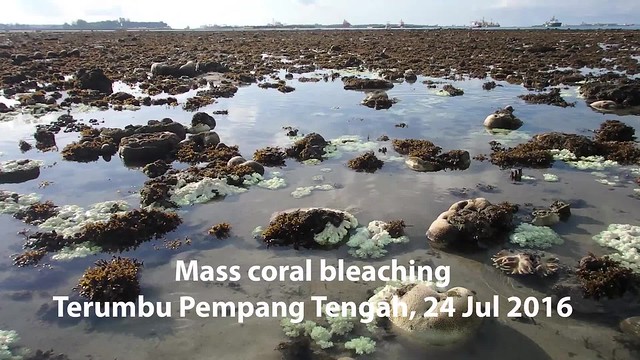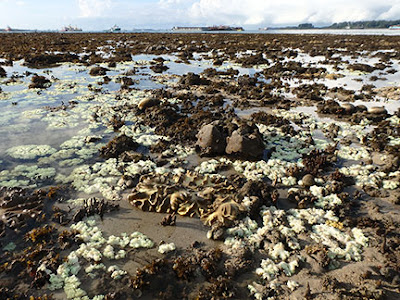We estimate about 10-80% of the hard corals and 40-50% of the leathery soft corals are bleaching. We estimate 5-10% of the corals have died recently.
Mass coral bleaching in Singapore is not unexpected. From the NOAA's coral reef watch satellite monitoring, Singapore is in the blue Watch zone. But our corals are still bleaching.
Here's a clip of the mass coral bleaching on the shore today.
Today, Pei Yan took drone footage of mass coral bleaching at Terumbu Pempang Tengah. It was heartbreaking to see the huge patch of subtidal corals completely white, and other patches of bleaching on the reef.
What is coral bleaching?
Coral are colonies of tiny animals called polyps. Each polyp lives inside a little hard skeleton. The huge colony is made up of the skeletons of countless polyps. The polyps of all reef-building hard corals harbour microscopic, single-celled algae (called zooxanthellae). The polyp provides the zooxanthellae with shelter and minerals. The zooxanthellae carry out photosynthesis inside the polyp and share the food produced with the polyp. Corals generally have white colour skeletons, which is believed to assist in photosynthesis by reflecting light onto the zooxanthellae.
 |
| There were many leathery soft corals in the area I surveyed. About half of them were NOT bleaching. |
Hard corals harbouring zooxanthellae live close to the upper limit of temperature tolerance. Thus a temperature increase of even 1-2 degrees centigrade can redust in bleaching. It is believed that global warming will lead to massive bleaching. Once the cause of bleaching is removed, however, polyps may eventually regain zooxanthellae (which live freely in the water) and thus recover their health. But prolonged bleaching can kill corals and seriously damage large sections of a reef.
 |
| We also saw mass coral bleaching at Terumbu Pempang Darat. |
Most of the large coral colonies on the shore were Merulinid corals, and most of them were NOT bleaching.
Cauliflower corals and Brain corals were still bleaching, I did not see any colonies that were NOT bleaching. But for most other corals, there were both colonies that were bleaching, and those that were not. I did see some special corals that were not bleaching such as Anchor corals and this special Frog spawn anchor coral that I rarely see. I also saw some long mushroom corals that were not bleaching.
There is a large patch of Branching montipora corals near our landing point and most of them were not bleaching (although about 5% were dead). Although the other kinds of corals in the patch were bleaching.
Sadly, some of the bleaching corals had portions that look like they recently died.
Most of the leathery soft corals I saw were alright, only about 40% were bleaching. But some of those that were not bleaching showed stress, with portions covered in silt or portions covered with peeling 'skin', and some look like they were melting. I even saw one that was rotting with grey slimy patches that smelled bad. I only saw two small clusters of Asparagus flowery soft corals and both were bleaching.
There were many Frilly sea anemones and they were all bleaching. I saw one Smooth frilly sea anemone which Nick says might be another species, it was bleaching. I saw one Haddon's carpet anemone, one Magnificent anemone, two Giant carpet anemones both not bleaching. And one bleaching Bubble tip anemone. The Giant and Bubble tip anemones had anemonefishes. Some clumps of zoanthids was bleaching.
Among the interesting encounters I had today was with a medium sized Fluted giant clam (about 25cm). It was not bleaching! Sadly, giant clams can also bleach as they too contain zooxanthallae.
I also saw some Jorunna nudibranchs!
There were patches of Spoon seagrass and Sickle seagrass heavily covered in epiphytes, and some clumps of Tape seagrass with somewhat cropped leaf blades (about 20cm long). The seagrasses were doing much better when we last surveyed in Mar 2016.
Although we didn't come across any new fishing nets, the drone footage caught one large fish trap laid on the reef edge.
Here's the location of the submerged reef we visited today. 'Tengah' means 'middle' in Malay, while 'Laut' means 'seaward' and 'Darat' means 'landward'. These beautiful submerged reefs may be affected by reclamation in the future.
The 2030 Landuse Plan by the Ministry of National Developmentreleased in Jan 2013 shows plans for 'possible future reclamation' (in light blue surrounded by dotted lines) that may impact Terumbu Pempang Darat and Terumbu Pempang Tengah. More about thepossible impact of the 2030 Landuse Plan on our shores.
 |
| Click on image for larger view. |
 |
| Click on image for larger view. |
High res photos of mass coral bleaching in Singapore for free download on wildsingapore flickr
Posts by others on this trip
- Russel Low on facebook
- Richard Kuah on his blog.
- Lisa Lim on facebook.















